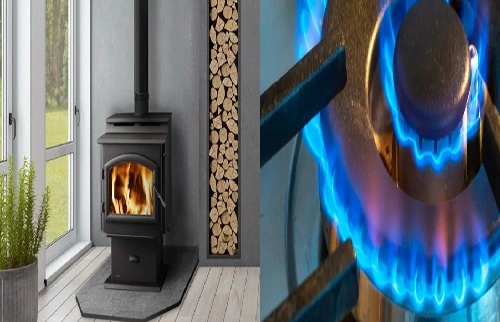As winter approaches, homeowners across the USA face an important decision: how to heat their homes efficiently while maintaining comfort and ambiance. Two popular heating solutions are wood-burning stoves and gas stoves. Both options offer warmth, charm, and unique benefits, but they differ in terms of cost, maintenance, convenience, and environmental impact.
In this article, we’ll explore the key differences between wood-burning stoves and gas stoves, helping you determine the best choice for your home and lifestyle.
1. How They Work
Wood-Burning Stove
A wood-burning stove generates heat by burning natural firewood. These stoves are typically made of cast iron or steel and have a firebox where wood is loaded and burned. Heat radiates through the stove’s body and glass window, warming the surrounding area.
- Fuel Source: Logs, firewood, or wood pellets.
- Operation: Requires manual lighting, regular feeding of wood, and adjustments to control airflow for burn efficiency.
Gas Stove
Gas stoves use natural gas or propane as fuel. They have a burner system that produces flames, typically enclosed in a firebox with decorative ceramic logs or embers for realism. Gas stoves are connected to a gas line or portable propane tank and are operated with a switch, thermostat, or remote control.
- Fuel Source: Natural gas or propane.
- Operation: Quick ignition with minimal effort, often with automated temperature control.
2. Heat Output and Efficiency
Wood-Burning Stove
Wood stoves produce intense heat and are highly effective at heating large areas or single rooms. Modern wood stoves are EPA-certified, meaning they burn wood more efficiently and produce fewer emissions compared to older models. However, heat output depends on the quality and dryness of the wood.
- Efficiency: 60–80% (modern EPA-certified stoves).
- BTU Output: Up to 60,000 BTUs, depending on the stove size and wood quality.
Gas Stove
Gas stoves provide consistent, controlled heat and are often more efficient than wood-burning stoves. Many models come with built-in thermostats, allowing homeowners to maintain a specific temperature effortlessly. Gas stoves are ideal for supplemental heating or warming up spaces quickly.
- Efficiency: 70–90%, depending on the model.
- BTU Output: Up to 40,000 BTUs for residential gas stoves.
Winner: Gas Stoves for efficiency and consistent heat control. Wood stoves excel in heat output for larger spaces.
3. Convenience and Ease of Use
Wood-Burning Stove
Wood stoves require hands-on effort, including:
- Chopping, storing, and hauling firewood.
- Lighting the fire manually and feeding logs regularly.
- Cleaning out ash and soot.
While the process can be rewarding for those who enjoy the ritual of tending a fire, it’s less convenient for busy homeowners.
Gas Stove
Gas stoves are extremely convenient and user-friendly. Features like push-button ignition, thermostatic controls, and remote operation allow homeowners to enjoy instant heat with minimal effort. Gas stoves require no fuel preparation or cleanup, making them ideal for modern lifestyles.
Winner: Gas Stoves for convenience and ease of use.
4. Cost of Operation
Wood-Burning Stove
- Initial Cost: $1,000–$3,000 for a modern wood stove, plus installation and chimney costs.
- Operating Costs: Firewood is relatively inexpensive or even free if you have access to your own supply. Costs vary by region but typically range between $100–$300 per cord of wood.
- Maintenance Costs: Regular chimney cleaning is essential to prevent creosote buildup, which can lead to chimney fires.
Gas Stove
- Initial Cost: $2,000–$4,500 for a gas stove, including installation.
- Operating Costs: Gas is priced per cubic foot or gallon (for propane). Natural gas is typically cheaper than propane, with average monthly costs ranging between $20–$150, depending on usage and regional rates.
- Maintenance Costs: Annual inspections are recommended, but gas stoves require less maintenance than wood-burning stoves.
Winner: Wood-Burning Stove for long-term savings if you have access to free or low-cost wood. Gas stoves have higher upfront and fuel costs but offer lower maintenance expenses.
5. Environmental Impact
Wood-Burning Stove
Modern wood stoves are more environmentally friendly than older models, but they still produce smoke, soot, and particulate matter that contribute to air pollution. Using well-seasoned wood minimizes emissions, but wood stoves generally have a larger environmental impact compared to gas stoves.
Gas Stove
Gas stoves burn cleanly, producing fewer emissions compared to wood stoves. However, natural gas is a nonrenewable fossil fuel and contributes to greenhouse gas emissions (methane). Propane, while cleaner than natural gas, still has environmental downsides.
Winner: Gas Stoves for cleaner emissions and lower environmental impact in the short term. Long-term sustainability depends on using renewable energy alternatives.
6. Aesthetic and Ambiance
Wood-Burning Stove
There’s no substitute for the charm of a real wood fire. The crackling sound, warm glow, and scent of burning wood create a cozy, rustic ambiance that’s hard to match. Wood stoves are perfect for homeowners who value atmosphere and traditional warmth.
Gas Stove
Gas stoves provide realistic flames, often with ceramic logs or glowing embers, to mimic the look of a wood fire. While they lack the sound and scent of real wood, gas stoves offer a clean, modern aesthetic and instant ambiance.
Winner: Wood-Burning Stove for authenticity and traditional charm.
Which Should You Choose?
- Choose a Wood-Burning Stove If:
- You love the natural look, sound, and scent of a real wood fire.
- You have access to affordable or free firewood.
- You enjoy hands-on operation and maintenance.
- You want to heat large spaces efficiently and reduce heating costs.
- Choose a Gas Stove If:
- You prioritize convenience and ease of use.
- You prefer instant, consistent heat with minimal effort.
- You want a cleaner, low-maintenance heating solution.
- You live in areas where gas is readily available.
Conclusion
Both wood-burning stoves and gas stoves offer distinct advantages, making them excellent heating options depending on your priorities. A wood-burning stove is perfect for those who appreciate the rustic charm, hands-on experience, and cost-effectiveness of burning wood. In contrast, a gas stove is ideal for homeowners who want a hassle-free, efficient, and clean heating solution with modern convenience.
Ultimately, the right choice comes down to your personal preferences, budget, and lifestyle. Whether you’re drawn to the crackling warmth of a wood fire or the instant comfort of gas heating, both options can provide a cozy and inviting atmosphere for your home.


